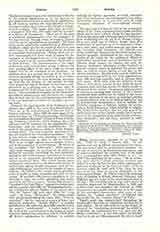

Volta, ALESSANDRO, physicist, b. at Como, February 18, 1745; d. there, March 5, 1827. As his parents were not in affluent circumstances his education was looked after by ecclesiastical relatives. At the age of seventeen he finished his humanities, and at nineteen disclosed the scientific bent of his mind in a correspondence with Abbe Nollet (q.v.). In 1769 Volta published his first paper, “De vi attractiva ignis electrici”, which attracted attention and helped to secure for him his first public appointment, professor of physics in the Liceo of Como (1774), a position which he held until 1779, when he was elected to the chair of natural philosophy in the University of Pavia. In 1782 he visited the principal seats of learning in France, Holland, Germany, and England, and met many of the representative men of the day. The twitching of frogs’ legs under electrical stimulus, discovered by Swammerdam in 1658 and rediscovered and described by Galvani in 1786, occasioned a memorable controversy as to the cause of the convulsive movements; after years of discussion the “animal electricity” of Galvani was superseded by the “contact theory” of Volta. Volta’s work was characterized throughout by forethought; there was no empiricism, nothing due to mere chance. In his endeavor to test his theory, he invented the “condensing electroscope” by which he established the fundamental fact that when two dissimilar conductors, e.g. zinc and copper, are brought together in air and then separated, the zinc is found to have a small positive, and the copper an equal negative charge, a result which has been confirmed by subsequent investigators working with more delicate instruments, notably by Lord Kelvin. Anterior to this, in 1775, Volta devised his electrophorus by means of which, given a small initial electrification, mechanical work may be transformed at will into energy of electrostatic charge. Though the principle involved was known to Canton of London in 1753, and though Wilcke of Sweden described an electrophorus in 1762, Volta’s was the first practical machine of the kind and, therefore, the prototype of the rotary influence machines of the present day, such as the Holtz, the Voss, and the Wimshurst. In 1777 he proposed a system of electric telegraphy in which signals were to be transmitted by means of his electrophorus over a line extending from Como to Milan. The first use of static electricity for telegraphic purposes was, however, suggested in the “Scots Magazine” for 1753 and carried out on a small scale in 1774 by Lesage of Geneva.
In seeking further experimental evidence in favor of his contact theory, Volta was led to the greatest of his inventions, the voltaic “pile”, which he described in a communication of March 20, 1800, to Sir Joseph Banks, President of the Royal Society of London. Consisting as it did of a number of discs of zinc and copper separated by pieces of wet cloth and arranged in a vertical column, it was appropriately called a “pile”; a more efficient arrangement was, however, soon found by Volta in the “crown of cups”. The voltaic battery of 1800 marks an epoch in physical theory as well as in the application of science to the welfare of mankind. Though Volta lived twenty-seven years after the crowning invention of his life, it is a significant fact that he added nothing of note to his great work, leaving to Carlisle and Nicholson in 1800 to use the current furnished by a “pile” to decompose water; to Sir Humphry Davy in 1807 to separate sodium and potassium from their alkalis by the same means; and to Oersted of Copenhagen the cardinal discovery in 1820 of the magnetic effect of the electrical current.
Honors were showered on Volta by the academies and learned societies of Europe. Napoleon invited him to Paris in 1801 and made him an associate member of the Institut de France and later a senator of the Kingdom of Italy. In 1815 the Emperor of Austria appointed him director of the philosophical faculty of the University of Padua, a dignity which he resigned four years later in order to retire into private life. In the summer of 1899, the centenary of the invention of the voltaic battery, an exposition was held in Como of electrical apparatus constructed and used by Volta in his investigations, but unfortunately a fire broke out and many of these heirlooms of science were destroyed. Three practical units have been named after Catholic electrical pioneers; the volt, the unit of electrical pressure, in honor of Volta; the coulomb; the unit of electrical quantity, in honor of Charles Augustin de Coulomb; and the ampere, the unit of current, in honor of Andre-Marie Ampere.
BROTHER POTAMIAN

